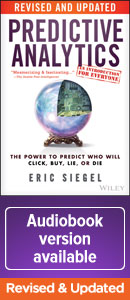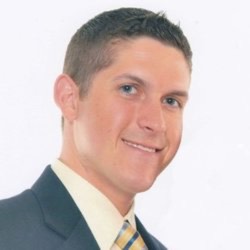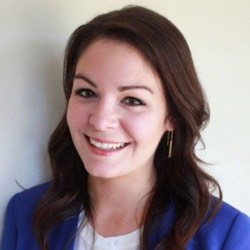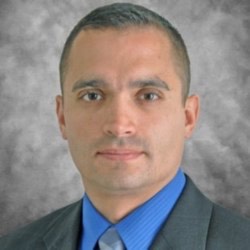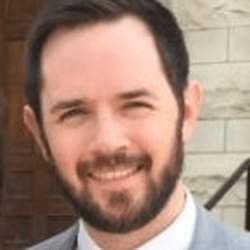Conference Day 1: Tuesday, May 16, 2017
8:00-8:30am • Room: Grand Assembly
Registration
Networking Breakfast
8:30-8:35am • Room: Nob Hill BC
Conference Chair Welcome
8:35-9:20am • Room: Nob Hill BC
Keynote
Making Predictive Analytics Work in Your Enterprise
Today's executives are applying pressure to utilize predictive analytics techniques to improve their bottom line. Human Resources and Lines of Business have a unique set of challenges as they apply these techniques to deliver value to the business. Challenges include little definition or guidance for identifying, framing and successfully deploying predictive analytics solutions, and extends to imperfect data, data politics and the challenge of communicating data science to a non-data science audience.
This presentation will cover topics on how workforce data scientists can: build business support for these efforts, ensure they return value to the entire organization, scope and frame projects appropriately; develop a plan for successful deployment, and communicate outcomes to the business.
[ Top of this page ] [ Agenda overview ]
9:20-10:10am • Room: Nob Hill BC
Plenery Session
What to Optimize? The Heart of Every Analytics Problem
Every analytics challenge reduces, at its technical core, to optimizing a metric. Product recommendation engines push items to maximize a customer's purchases; fraud detection algorithms flag transactions to minimize losses; and so forth. As modeling and classification (optimization) algorithms improve over time, one could imagine obtaining a solution merely by defining the guiding metric. But are our tools that good? More importantly, are we aiming them in the right direction? I think, too often, the answer is no. I'll argue for clear thinking about what exactly it is we ask our computer assistant to do for us, and recount some illustrative war stories. (Analytic heresy guaranteed.)
10:10-10:40am • Room: Salon 9
Exhibits & Morning Coffee Break
10:40-11:25am • Room: Nob Hill BC
Track 1: Business
Yin-Yang: Statistical Modeling to Predict Attrition and Productivity/Output Metrics
Attracting and retaining the right talent continues to be a struggle, especially in the Silicon Valley. Advances in statistical modeling have allowed us to predict and understand in depth and breadth why employees leave companies. But can these same methods be replicated and extended to predict positive outcomes, i.e. productivity/ooutput metrics? This presentation will walk through some of the analytic techniques being used at Twitter, such as survival analysis, decision trees, etc. being used to predict employee attrition and operational outcomes for tech and sales employees. We will also share our learnings and some practical considerations using these techniques.
10:40-11:25am • Room: Nob Hill D
Track 2: Technical
Use Case: Using a data driven approach to identify Information Security risk among Netflix employees
The Netflix corporate ecosystem is comprised of a number of enterprise applications and internally developed tools, managing business processes for employees, engaging with partners and enabling an efficient development environment. These applications differ in technology stack, function, access, and authorship. As a result, detecting suspicious activity across these applications may entail sifting through a variety of logs in varying formats - therefore, tedious and error-prone. Leveraging machine learning techniques and sophisticated analyses is quintessential for detecting these activities at scale.
In this session, I'll present the data processing architecture, the analytic component that identifies abnormal patterns, a rules engine and the overall modular framework that fits all these pieces together to provide an end-to-end solution. I'll share some critical success factors and learnings as we embarked on a journey to analyze corporate application logs for anomalous activities.
[ Top of this page ] [ Agenda overview ]
11:30am-12:15pm • Room: Nob Hill BC
Track 1: Business
Use Case: How Kforce Is Evolving From Pre-Hire Assessments to Predictive Hiring
Historically, leaders have chosen job candidates they believe to be the "best fit" for the job with a combination of "gut" and general guidance from Talent Assessments. Their hiring decisions were rarely measured against actual business results - the will, the data, and methods were not there. Today's predictive analytics methods provide the ability to close that loop, for a fact-driven hiring decision process to identify potential superstars.
This session will describe Kforce's evolution along this path, bringing us to a dynamic, multi-model predictive hiring solution.
We will describe our problem definition, HR and KPI modeling, Employee Cost and Lifetime Value modeling, predictive model process, and logistics as we brought this solution live. Be prepared to learn all about one company's journey to Predictive Workforce Analytics.
11:30am-12:15pm • Room: Nob Hill D
Track 2: Technical
The Hero with a Thousand Faces: Data Science and Storytelling
It is often said that the most important aspect of data science is not the data, but the question asked of the data. Whether an answer lies within any particular data set is something to be determined by the analysis, but once an answer is found, the next most important step in order to drive action is storytelling. In the words of the great Maya Angelou, "people won't remember what you said, but they will remember how you made them feel."
In this interactive presentation, Nery explores ways in which the ancient drive to tell stories continues to influence modern data science.
[ Top of this page ] [ Agenda overview ]
Lunch in the Exhibit Hall
1:45-2:35pm • Room: Nob Hill BC
Keynote
How to Use Survival Analytics to Predict Employee Turnover
Employee turnover is one of the most expensive and pervasive problems in workforce analytics. Many practitioners attempt to predict it with logistic methods, which are inflexible and conceptually flawed for the problem.
Survival methods, born in medical statistics, often predict better, because they resolve the complex relationship between turnover and tenure. As a bonus, survival figures can be used for risk weighting and lifetime value calculations.
Cast aside your fixed-period assumptions, and come learn how to model, validate, and deploy survival methods for your hardest turnover problems.
2:40-3:25pm • Room: Nob Hill D
Track 1: Business
Use Case: When Predictive Analytics Isn't Enough
How We Got 10X Greater ROI Than We Could with Predictive Models
If you have ever had a business challenge that defied predictive modeling due to its complexity and complex webs of interdependencies, if you have ever struggled with establishing causality in order to solve a hairy but extremely valuable business challenge, than you will enjoy diving into a couple case studies where we built from our predictive models into a more complete systems model in order to unlock significantly more business value.
We will walk through how we solved a $200M+ attrition problem and a recruiting cost increase by making a couple small changes in the budgeting and workforce planning process.
2:40-3:25pm • Room: Nob Hill BC
Track 2: TechnicalOpen Sourced Workforce Analytics: A Live Demonstration of Tools and Techniques for Predictive Modeling
The ability to leverage free open sourced technologies has become a critical part of gaining an effective workforce analytics capability. During this session, Jason will present several project case studies, the algorithms applied, and the free open sourced software programs used. The project case studies will also address the following predictive modeling challenges:
- Visualizing the impact of important patterns to drive action
- Make predictions as accurately as possible
- Rashomon effect and the multiplicity of good models
Jason will also provide demonstrations of the free open sourced software programs throughout this session using sample data.
Exhibits & Afternoon Break
3:55-4:40pm • Room: Nob Hill BC
Track 1: Business
Use Case: How CenturyLink Measures How Well Leaders Manage Their Organizations
This presentation will discuss how CenturyLink developed a solution that combined key HR metrics to comprehensively measure how well leaders are managing their organizations. It will discuss how to design a similar process in your own organization, get the executive buy-in you need to make an impact, and use existing data and processes to contribute to a predictive analytics agenda.
3:55-4:40pm • Room: Nob Hill D
Track 2: TechnicalCase Study: Provoking Innovation On the Edge of Business with Analytics
The fervor of big data and business analytics have led to a bumper crop of education, training, tools, and methods. It's difficult to detect the signal from the noise of those same people, processes, and tools that exist to distinguish signals from noise. This session will share case studies of how commercial and national government programs are developing (or stumbling) their analytics programs and how Dynamic Bayesian Networks have been used to guide investments in the same. Certifications will be assessed as mechanisms to validate important skills to help organizations develop their programs by identifying, hiring, and retaining world-class talent.
4:45-5:30pm • Room: Nob Hill BC
Track 1: BusinessPredicting and Improving Employee Performance
Employee performance is a critical area with significant financial implications for companies. GE set out to understand what drives performance in employees and created solutions to monitor and improve performance. In this session, I will share how we have approached the following:
- Predict performance,
- Challenge previous assumptions,
- Communicate insights to business leaders, and
- Collaboratively create action plans.
4:45-5:30pm • Room: Nob Hill D
Track 2: Technical
Getting the Most from Your Predictive Models: Exploring the Impact of Segmentation on Common Modeling Techniques
One common technique that is emerging in predictive modelling in People Analytics (especially in attrition modelling) is the use of Segmentation to improve the accuracy and granularity of predictions. This approach works by breaking one model into multiple models. It can be applied using unsupervised or prescriptive splits on the dataset and can be done with any type of statistical model. But how much value does this technique provide? Does it always work? What are the impacts on various modelling techniques such as logistic regression or random forest? This session will explore these questions and demonstrate some ways that you can evaluate the answers for yourself at your own company.
Networking Reception
Dinner with Strangers
Conference Day 2: Wednesday, May 17, 2017
8:00-8:30am • Room: Grand Assembly
Registration
Networking Breakfast
8:30-8:35am • Room: Nob Hill BC
Conference Chair Welcome Remarks
8:35-9:20am • Room: Nob Hill BC
Keynote
Weird Science: How to Know Your Predictive Discovery Is Not BS
"An orange used car is least likely to be a lemon." At least that's what was claimed by The Seattle Times, The Huffington Post, The New York Times, NPR, and The Wall Street Journal. However, this discovery has since been debunked as inconclusive. As data gets bigger, so does a common pitfall in the application of standard stats: Testing many predictors means taking many small risks of being fooled by randomness, adding up to one big risk. John Elder calls this issue vast search. In this keynote, PAW founder Eric Siegel will cover this issue and provide guidance on tapping data's potential without drawing false conclusions.
[ Top of this page ] [ Agenda overview ]
9:20-10:10am • Room: Nob Hill BC
Diamond Sponsor Presentation
Legal and Ethical Issues when using Predictive Analytics for Talent Acquisition
The use of predictive analytics for talent acquisition is moving at a blistering pace. Employers are increasingly turning to analytics and the promise it holds to streamline employment processes and ease the burdens on overwhelmed talent acquisition professionals. But does the use of workplace analytics raise any legal concerns? Has the government weighed in and is there any guidance? Join us for this engaging program as we explore the ethical and legal implications of workplace analytics and offer best practices for success.
10:15-10:35am • Room: Nob Hill BC
Track 1: BusinessUse Case: Enhancing the Quality of Predictive Modeling on College Enrollment
Predictive modeling has gained popularity in studying college enrollment due to fierce competition in higher education. To make informed decisions and allocate limited resources to improve enrollment, predictive modeling has been applied to challenge and change the traditional recruitment process. This session is intended for two learning outcomes:
Participants who are not familiar with predictive modeling will learn how to lay out a plan to collect and build a comprehensive data infrastructure and conduct predictive modeling.
Participants who have run predictive modeling will learn how to critically examine the quality of their predictive analyses.
 Feyzi Bagirov
Feyzi BagirovChief Business Officer, 592 LLC
Analytics Instructor, Harrisburg University of Science and Technology
10:15-11:00am • Room: Nob Hill D
Track 2: Technical
Case Study: SmarterHQ
When Model Interpretation Matters: Understanding Complex Predictive Models
Session description currently being confirmed. Check back!
10:40-11:00am • Room: Nob Hill BC
Track 1: Business
Using Analytics in Recruitment to Identify Improvement Opportunities
- How Shell identified the improvement opportunities
- How Shell communicated the analytical results to gain executive buy-in for the changes
- How the change management process was carried out
- Lessons learned
Exhibits & Morning Coffee Break
11:30am-12:15pm • Room: Nob Hill BC
Track 1: Business
The Pay Equity Revolution: How Advanced Analytics are Helping to Close the Gender Pay Gap in Organizations
Ensuring pay equity is an emerging priority of organizations, a trend driven by Legal/Regulatory changes, pressures from activist investors and greater understanding among executives of the business value of workforce diversity. Advanced, "predictive" analytics have become central to the process of assessing pay equity and determining the policy changes and specific pay adjustments required to eliminate pay disparities in a sustainable way. Typically this involves estimation of statistical models of base and total compensation to better understand and quantify the factors that drive pay in organizations and develop "predicted pay" levels against which "actual pay" can be compared. This session will show how companies are using predictive analytics to support their efforts around pay equity. We will focus on methodology and tools as well as the practical considerations involved in applying predictive modeling to solve the pay equity problem.
11:30am-12:15pm • Room: Nob Hill D
Track 2: Technical
Getting the most out of NLP for cover letter ranking, resume screening, interview conversations and more
Leveraging text in analytics can be intimidating for those getting started. This session will show how simple NLP can be, but also cover best practices and state-of-the-art tips for getting the most value out of this type of data. Applications include resume screening, interview conversation analysis, and letter/email topic discovery.
[ Top of this page ] [ Agenda overview ]
Lunch in the Exhibit Hall
1:30–2:15pm • Room: Nob Hill BC
Keynote
Use Case: How Predictive Models Improve Retail Sales Experience and Performance
Chico's FAS' is a specialty retailer of private label women's apparel, accessories and related products. Their brands include Chico's, White House Black Market, and Soma.
Demonstrating their commitment to leveraging data and insights to make better decisions, Chico's FAS has built an Advanced Analytics team comprised of technical experts with backgrounds in statistics, economics, engineering, etc. This Advanced Analytics team works closely with their brand partners to deliver higher value solutions for associates, customers and shareholders. One focus area for this team is workforce analytics.
This presentation will focus on:
- How to build a team of Advanced Analytics Specialists
- The infrastructure needed to affect the business and its evolution, and
- A predictive analytics use case to understand if it is possible to predict top retail associates pre-hire
Key Takeaways:
- Getting Started: Building a clear mission and vision
- Capability Building: Comparisons within or across domains, no matter what the size or scale of your company
- Big Data: How to make sense of it
- Advanced Analytics: Examples of models including response, predictive, attrition, etc.
2:15–3:00pm • Room: Nob Hill BC
Track 1: Business
Use Case: Changing Talent Management through Predictive Analytics
So you've built a predictive retention model. Great! Now what? How do you leverage predictive analytics to drive manager behavior change? Which key insights can you draw from your predictive retention work that can help drive change in staff resourcing, performance management, and recruiting?
2:15–3:00pm • Room: Nob Hill D
Track 2: Technical
How HR can take a giant leap via Artificial Intelligence
With the evolution of the Artificial Intelligence domain, several new technologies matured for prime time in HR. After Intel acquired Saffron, a cognitive computing company, our talent intelligence decided to leverage its platform and to improve current processes, and make our HR department more data-driven and effective. We tested several applications: Talent mobility, Employees progression, Talent acquisition, Skills analysis and more. In the session, we will take you through our journey and share some results, our learnings and how we see the future of AI in the future world of talent management.
[ Top of this page ] [ Agenda overview ]
Exhibits & Afternoon Break
3:30–4:15pm • Room: Nob Hill BC
Track 1: Business
Real World Lessons in Predicting Employee Retention and Engagement
Mike Rosenbaum will share results, best practices, and lessons learned from our work with several health care clients. While most of this work starts with reducing employee turnover, it expands to address other outcomes including improving patient satisfaction, deepening employee engagement, lowering hospital readmissions, increasing quality of care, and predicting other roles where the candidate could be a good fit.
3:30–4:15pm • Room: Nob Hill D
Track 2: Technical
Use Case: Predicting Safety and Performance from Unstructured Data
Recent breakthroughs in computing have enabled a whole new class of HR analytics. New ensemble learning techniques have overtaken classical linear approaches to model building for most problems and data competitions. In addition to new modeling techniques new unstructured datasets from social, resume, assessments, and interview are being used for new insights. This session will communicate these important changes in a simple format and show problems being solved with real data including predicting candidate performance and safety. Adverse impact mitigation will also be discussed in regards to model building.
[ Top of this page ] [ Agenda overview ]
4:15-5:00pm • Room: Nob Hill BC
Panel:
Politics, Power Tools and Perfect Data
In this panel, we will discuss some of the practical aspects of getting a predictive analytics assignment started and completed within an organization. Hence, the "politics" in dealing with data ownership and business process control, "power tools" in terms of the advanced data/statistical tools that we have available today, and "perfect data" in terms of the fact that our data will never be so.
The over-arching goal is to help people in the audience get a project started and deployed into operations.
[ Top of this page ] [ Agenda overview ]
